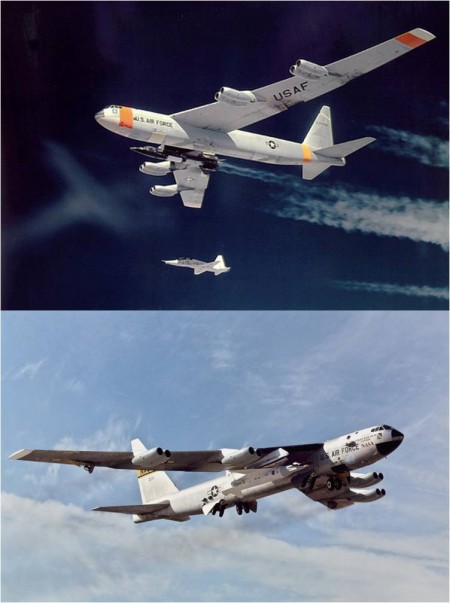Eight years ago today, NASA’s storied NB-52B Stratofortress launch aircraft was retired following 44 years of service to the American flight research community. Although it was on flying status for nearly 50 years, the aircraft accumulated a total of only 2,443.8 flight hours.
The aircraft that became the NASA NB-52B (S/N 56-0008) started life as an RB-52B when it rolled off of the Boeing assembly line in 1955. First flight occurred on Saturday, 11 June 1955. USAF employed the aircraft as a testbed for B-52 bomb navigation systems.
In June of 1959, the aircraft joined the X-15 Program as a launch aircraft for North American’s famous manned hypersonic flight research rocket plane. Now designated as NB-52B, the eight-engine behemoth had previously been modified for the “mothership” role. The aircraft ultimately acquired the moniker “Balls 8” in deference to the last 4 digits in its USAF serial number.
Based at Edwards Air Force Base in California, the NB-52B made its X-15 Program debut on Saturday, 23 January 1960. On this day, Balls 8 launched X-15 Ship No. 1 (S/N 56-6670) with North American test pilot Scott Crossfield at the controls. It was the fifth flight test of the X-15 Program.
When the X-15 Program ended in late 1969, NASA’s NB-52B had served as the launch aircraft for roughly 140 of the X-15’s 199 research flights. But there would be many more chapters written in the hugh mothership’s story. Indeed, this story would continue to unfold over the next 35 years.
The list of flight test programs supported by Balls 8 is impressive by any measure. Among others, the NB-52B served as the launch aircraft for the legendary lifting body series (M2-F2, M2-F3, HL-10, X-24A and X-24B). Included in this list is the X-38 Crew Return Vehicle (CRV).
NASA’s NB-52B served as the first carrier aircraft for Orbital Science’s Pegasus air-launched, winged, multi-stage rocket. Balls 8 also supported the Space Shuttle Program by dropping solid rocket booster test vehicles to flight test the Shuttle booster’s parachute recovery system. The Space Shuttle Orbiter’s retro-fitted landing drogue parachute was also tested by Balls 8.
The last flight research project supported by NASA’s fabled NB-52B was the HYPER-X Program. This experimental effort involved flight testing an airframe-integrated scramjet engine on an X-aircraft known as the X-43A. Fittingly, Balls 8’s last flight test program would be like its first in that both involved hypersonic flight.
Balls 8 made its last flight on Tuesday, 16 November 2004. The mission was entirely successful as the X-43A scramjet operated at Mach 9.68 (6,598 mph at 110,000 feet). Balls 8 triumphantly returned to Edwards Air Force Base and performed one final flyover of the NASA Dryden Flight Research Center. The aircraft actually made two landings as first the co-pilot and then the command pilot landed on the concrete.
Balls 8 was officially retired on Friday, 17 December 2004 in ceremonies jointly conducted by USAF and NASA. As part of the festivities, NASA returned the NB-52B to the Air Force since technically the aircraft had been on indefinite loan to NASA since the late 1950’s! Today, the aircraft is on public display outside just the north gate at Edwards Air Force Base.


